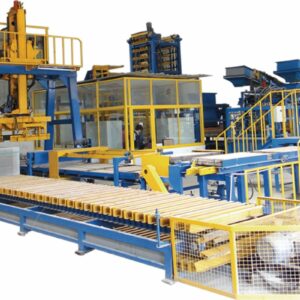Block-making machines contribute significantly to rapid construction techniques by streamlining several aspects of the building process:
- Speed of Production: These machines can produce a large volume of building blocks, such as bricks, concrete blocks, or interlocking blocks, in a relatively short time compared to traditional methods of block production.
- Quick Assembly: The standardized and precise blocks produced by these machines facilitate rapid assembly on-site, reducing the time required for laying foundations and constructing walls or structures.
- Modular Construction: Blocks produced by these machines are often designed for easy stacking and interlocking, enabling modular construction techniques. This approach allows for swift assembly, similar to piecing together building blocks, reducing construction time significantly.
- Reduced Manual Labor: Automated or semi-automated processes involved in block production minimize the need for extensive manual labor, leading to faster and more efficient construction practices.
- Standardization and Consistency: Blocks manufactured by these machines are uniform in size, shape, and quality, ensuring consistency throughout the construction process. This uniformity speeds up construction, as workers can easily work with standardized components.
- Ease of Handling: These blocks are designed for ease of handling, transportation, and installation. Their standardized shapes and dimensions simplify the construction process, blocks machine price allowing for quicker and more efficient assembly.
- Versatility in Applications: Blocks produced by these machines can be used in various construction techniques, including load-bearing walls, partitions, retaining walls, and more, contributing to the versatility and speed of construction.
- Optimization of Building Processes: These machines optimize material usage, reduce waste, and enhance the overall efficiency of the building process, contributing to faster project completion.
- Suitability for Different Construction Scales: Whether for small-scale projects or large-scale construction endeavors, block-making machines adapt to different construction scales, providing a rapid and efficient solution.
- Support for Prefabrication: The blocks manufactured by these machines are often used in prefabricated construction methods, allowing for off-site production and swift on-site assembly, further enhancing construction speed.
In summary, block-making machines play a pivotal role in expediting construction processes through their ability to produce standardized, high-quality blocks rapidly. Their contributions include standardized production, ease of handling, modular construction techniques, and the overall optimization of construction workflows.
How does blocks machine handle different block finishes and surface textures?
Block-making machines are designed to handle various block finishes and surface textures through specific adaptations and processes:
- Mold Design: These machines feature molds designed to create different surface textures and finishes on blocks. Molds may have distinct patterns, shapes, or textures imprinted on their surfaces, imparting unique finishes to the blocks.
- Surface Treatments: Some machines incorporate surface treatment options within the block-making process. These treatments may include brushing, polishing, or texturing mechanisms applied to the mold or block surface to achieve specific finishes.
- Interchangeable Molds: Machines often allow for the easy interchangeability of molds, enabling the production of blocks with different surface textures and finishes. Operators can swap molds to achieve various patterns or textures.
- Vibration and Compaction Control: The level of vibration and compaction applied during the block-making process influences surface texture. Control over vibration intensity and duration helps create smoother or more textured surfaces.
- Additives and Surface Enhancements: Incorporating additives or surface enhancement materials into the block mix can affect the surface texture and finish. For instance, using additives like colorants or surface treatments can create unique finishes.
- Customized Finishing Tools: Some advanced machines allow for the integration of customized finishing tools or attachments that modify the block surface during or after the molding process, providing diverse textures and finishes.
- Surface Coatings or Treatments: Post-production surface treatments or coatings can be applied to blocks to alter their appearance, texture, or durability after they are produced by the machine.
- Innovative Technologies: Advancements in block-making technology introduce innovative techniques or processes that directly influence surface texture and finish, offering more options for customization.
- Quality Control Measures: Machines often incorporate quality control measures to ensure consistency in surface texture and finish across produced blocks. Inspection processes help maintain desired surface qualities.
- Research and Development: Ongoing research and development efforts in block-making technology focus on improving surface texture and finish options, introducing new methods or materials to achieve desired aesthetics.
Overall, block-making machines offer versatility in producing blocks with various surface textures and finishes through mold design, process control, surface treatments, and innovations in technology. These capabilities enable the creation of blocks with diverse appearances, meeting architectural and design preferences in construction projects.
